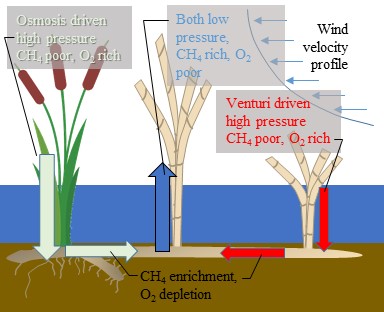All plants require oxygen in their root zone to survive, but when soils are inundated plants are unable to rely on oxygen that naturally occurs in the soil pore spaces. Many wetland plants have developed specialized gas transport structures to deal with this problem. These gas transport structures can take many forms, but almost all plants rely on some kind of porous tissue, usually referred to as aerenchymous tissue, to facilitate this task. While the structures are actually there to help the plant by moving oxygen to the soil, they can also serve as egress pathways for subsurface biogases like methane or nitrous oxide to escape to the atmosphere.
Oxygen can be moved to the soil through the aerenchymous tissue passively, via dispersive processes like molecular diffusion, or by active movement using convection. While the passive methods are relatively well understood, there are still a lot of open questions about how the convective processes proceed and what the effects those processes would have on sub surface biogeochemistry.

Fluxes through the actual aerenchyma can be caused by a variety of different mechanisms. Wind velocity differentials can cause pressure gradients across the plant, which can in turn induce airflow through the lacunar space. Some plants can also use osmosis to create a similar pressure gradient.
While most models seeking to forecast methane or nitrous oxide emissions from wetlands acknowledge aerenchymous transport of greenhouse gases, at present they all formulate this transport as if it followed the passive mechanism, while it appears to be the case that many plants in temperate and tropical latitudes actually use the advective mechanism.
I seek to address these knowledge and technique gaps by combining new measurement techniques with novel model formulations and innovative model parameterization subroutines. Ongoing work on Salix spp. and Typha spp. seek to gather the necessary data to characterize a mechanistic model for the process.